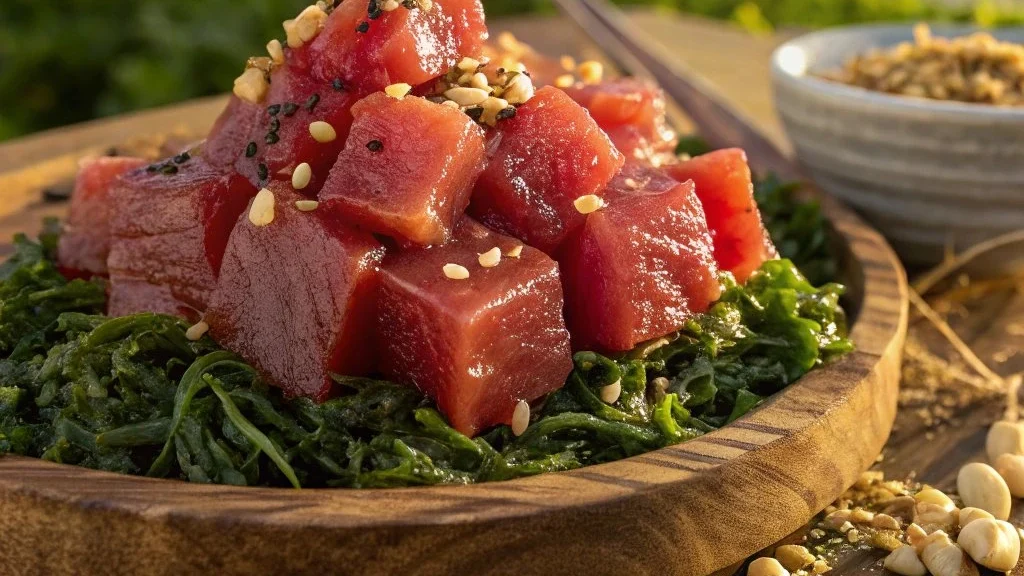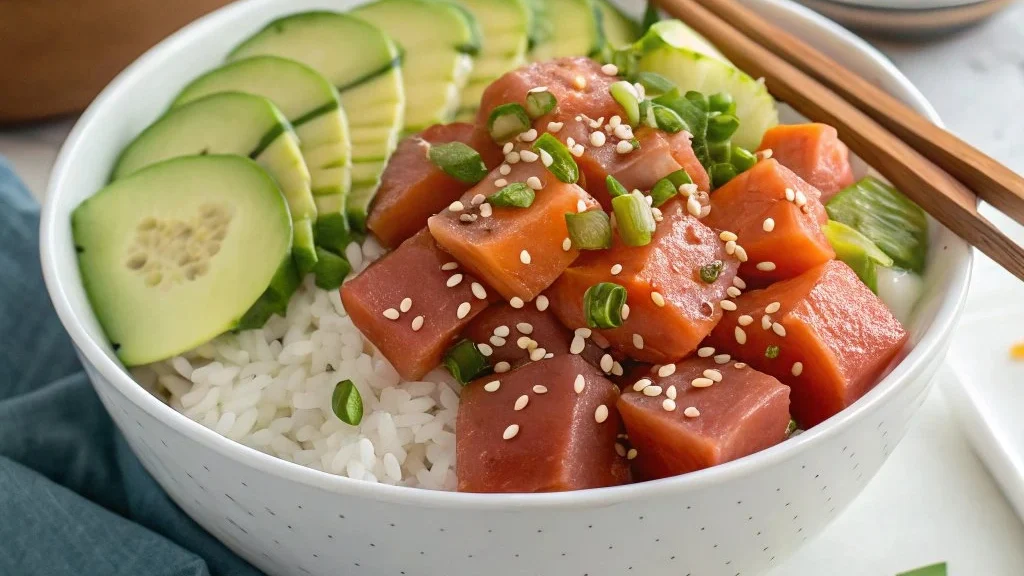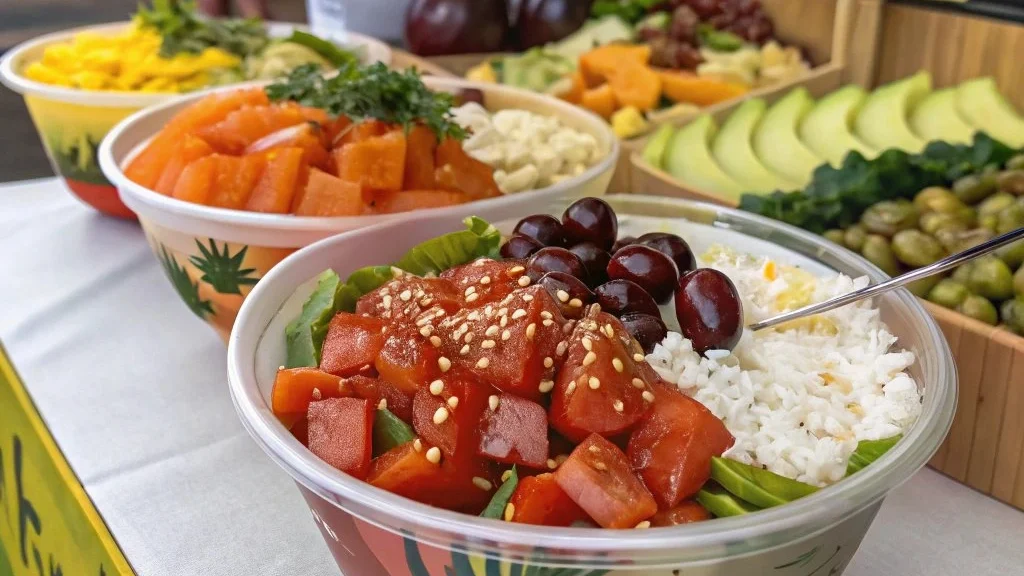Is Poke Hawaiian or Japanese? Poke, a dish celebrated for its freshness and versatility, has a fascinating story. How poke evolved from a simple Hawaiian tradition to a global culinary trend reflects the blending of cultures and the creativity of chefs around the world. This article explores the dish’s journey, from its origins on the islands of Hawaii to its modern-day variations enjoyed worldwide.
Table of Contents

The word “poke” (pronounced poh-kay) translates to “to slice” or “to cut crosswise” in Hawaiian, perfectly describing the method of preparing this dish. Traditionally, poke consists of raw, cubed fish seasoned with sea salt, limu (seaweed), and kukui nut. These simple yet flavorful ingredients reflect the natural bounty of Hawaii’s islands.
However, as Hawaii became a melting pot of cultures, Japanese immigrants brought their own culinary traditions, such as soy sauce, sesame oil, and rice, which became integral to the evolution of poke. This fusion of flavors transformed poke from a local delicacy into an internationally recognized dish.
In the sections that follow, we’ll uncover the Hawaiian roots of poke, the Japanese contributions that shaped its modern form, and how it became a global phenomenon.
Is Poke Hawaiian or Japanese? A Hawaiian Tradition
Poke is undeniably Hawaiian at its core. Its origins trace back centuries to the indigenous people of Hawaii, who relied on the ocean’s resources for sustenance. The traditional preparation of poke highlights the islanders’ deep connection to the sea and their ingenuity in utilizing fresh, local ingredients.
What is Poke? A Deep Dive into Its Origins and Ingredients
Poke, meaning “to slice” or “to cut crosswise” in Hawaiian, is a dish deeply rooted in Hawaiian culture and history. This beloved delicacy originated from the traditions of Native Hawaiian fishermen, who would prepare it as a quick, protein-rich snack after a long day at sea. By cutting freshly caught fish into bite-sized pieces and seasoning it with locally sourced ingredients, they created a dish that was not only delicious but also a reflection of the islands’ natural bounty.
Originally, reef fish such as ahi (yellowfin tuna) or heʻe (octopus) were the primary choices for poke. The dish was kept simple, using only a few essential seasonings that highlighted the fish’s freshness and natural flavors. The core ingredients of traditional Hawaiian poke included:
- Hawaiian Sea Salt (Paʻakai): More than just a seasoning, this mineral-rich salt played a crucial role in preserving the fish, keeping it fresh without refrigeration. The coarse texture also enhanced the fish’s natural umami flavor.
- Limu (Seaweed): A native seaweed that added a subtle briny, earthy depth to the dish, reinforcing its connection to the ocean. Different varieties of limu, such as limu kohu and limu manauea, were commonly used.
- Inamona (Kukui Nut): These roasted and ground candlenuts introduced a nutty, slightly bitter undertone, balancing the saltiness of the poke while adding a rich, smooth texture.
Beyond these core elements, poke was a testament to the Hawaiians’ resourcefulness, using what was readily available in their environment. The dish was more than just food—it was a way of life, deeply tied to the sea, sustainability, and the cultural heritage of the islands.
Over time, as different cultures influenced Hawaiian cuisine, poke evolved to include additional seasonings such as soy sauce, sesame oil, onions, and even spicy mayonnaise. However, at its heart, poke remains a simple, fresh, and flavorful dish that continues to honor its traditional roots while embracing modern culinary creativity.
Early Variations of Poke
Although the raw fish-based poke we know today is the most recognized version, early poke was not limited to seafood. Hawaiians also used cooked octopus (heʻe) or even raw crab. Over time, raw ahi (yellowfin tuna) became a preferred choice, thanks to its abundance in Hawaiian waters and its delicate flavor.
Poke was often served in its simplest form, highlighting the freshness of the fish and the purity of the seasoning. It was a communal food, enjoyed at gatherings and celebrations, further embedding it into Hawaiian culture.

Japanese Influence on Modern Poke
While poke has its roots in Hawaii, how poke evolved into its modern form owes much to Japanese immigrants who arrived in the late 19th and early 20th centuries. As these immigrants introduced their culinary traditions to the islands, they brought new ingredients and preparation techniques that would forever transform the dish.
Japanese Immigration to Hawaii
Japanese workers came to Hawaii to work on sugar plantations, bringing with them a rich culinary heritage. Over time, their influence extended beyond the plantation kitchens, blending seamlessly with native Hawaiian cooking practices. This cultural exchange became a key part of how poke evolved over time.
Key Contributions to Poke
The Japanese influence on poke is undeniable in its modern iterations. Some of the key ingredients introduced include:
- Shoyu (Soy Sauce): A salty, umami-rich seasoning that complements raw fish perfectly.
- Sesame Oil: Adds a nutty aroma and enhances the dish’s flavor.
- Green Onions and Ginger: These aromatics brought brightness and complexity to poke.
- Rice: Serving poke over steamed white rice transformed it into a complete meal, birthing the now-famous poke bowl.
These additions not only expanded the flavor profile of poke but also made it more accessible and appealing to a broader audience. This is a crucial step in how poke evolved into the dish we know today.
How Poke Evolved Over Time
The evolution of poke from a traditional Hawaiian dish to a modern culinary phenomenon reflects the blending of cultures and the creativity of chefs around the world. Over time, how poke evolved saw it adapting to new ingredients, techniques, and presentation styles while still retaining its core identity as a celebration of fresh, raw fish. Moreover, the dish’s transformation highlights how food evolves through cultural exchanges, making it both timeless and innovative.
The Global Popularity of Poke
In the past decade, poke has transcended its Hawaiian origins to become a global culinary phenomenon. Restaurants dedicated to poke have emerged in cities worldwide, from Los Angeles to London, offering innovative spins on this classic dish.
Poke in the United States
The poke craze in the mainland United States began around the mid-2010s, fueled by the health food movement and the popularity of sushi. Restaurants began offering poke bowls featuring ahi tuna, salmon, and tofu, served with an endless variety of toppings and sauces.
California played a significant role in popularizing poke, with its culinary scene already embracing fresh seafood and fusion cuisine. Soon, poke shops spread to major metropolitan areas, each offering their unique take on the dish.
Variations of Poke in Different Countries: A Global Twist on a Hawaiian Classic
As poke gained international popularity, it began to evolve, adapting to local ingredients, flavors, and culinary traditions in various countries. While the essence of poke—a dish centered around fresh, marinated raw fish—remains the same, different cultures have put their own unique spin on it.
🇯🇵 Poke in Japan: The Chirashi Influence
In Japan, poke bowls often resemble chirashi, a traditional Japanese dish that consists of sliced raw fish served over a bed of sushi rice. However, Japanese-inspired poke variations tend to be lighter and more delicate in flavor, incorporating ingredients commonly found in sushi, such as:
- Shoyu (Soy Sauce): Adds a deep umami taste, similar to Hawaiian-style poke.
- Wasabi: Provides a spicy kick, enhancing the natural flavors of the fish.
- Pickled Ginger: Offers a refreshing, slightly tangy contrast to the richness of the fish.
- Ikura (Salmon Roe): Brings a burst of briny flavor and a unique textural element.
- Shiso Leaves: A fragrant herb with citrusy and minty notes, elevating the freshness of the dish.
Japanese poke is typically more minimalist, focusing on the balance of flavors and quality of the fish, much like traditional sushi.
🇦🇺 Poke in Australia: A Tropical Twist
Australia, with its abundance of tropical fruits and fresh seafood, has embraced poke with a vibrant, refreshing twist. Many Australian poke bowls feature tropical ingredients that reflect the country’s coastal lifestyle, including:
- Passion Fruit: Adds a tangy, sweet contrast to the savory fish.
- Pineapple Chunks: Enhances the dish with a natural sweetness that pairs well with tuna or salmon.
- Macadamia Nuts: Offers a rich, buttery crunch, similar to the traditional Hawaiian inamona (kukui nuts).
- Avocado & Mango: Provides a creamy, sweet contrast, making the dish more indulgent.
These tropical additions make Australian poke bowls bright, fruity, and full of fresh flavors, often served with a base of sushi rice or even coconut-infused rice.
🇪🇺 Poke in Europe: Mediterranean Fusion
In Europe, particularly in coastal Mediterranean regions, poke has been influenced by the bold and savory flavors of Mediterranean cuisine. European chefs often incorporate:
- Olives & Capers: Briny, salty elements that add depth and complexity.
- Feta Cheese: A creamy, tangy cheese that complements the freshness of the fish.
- Sun-Dried Tomatoes: Provides a concentrated sweetness and umami boost.
- Extra Virgin Olive Oil & Lemon Zest: Enhances the dish with a rich, citrusy brightness.
European poke bowls are often served with quinoa, couscous, or mixed greens instead of traditional sushi rice, making them lighter yet still satisfying.
🌎 The Global Appeal of Poke
These diverse interpretations highlight how poke has transcended its Hawaiian origins, evolving into a dish that embraces flavors from all over the world. Whether you prefer the minimalism of Japan, the tropical vibrance of Australia, or the Mediterranean richness of Europe, poke continues to be a dish that adapts to local tastes while staying true to its fresh and nourishing essence.
No matter where you are, you can enjoy a poke bowl that reflects your culinary culture, favorite ingredients, and personal preferences—making it one of the most versatile and universally loved raw fish dishes today.versatility, allowing it to thrive in diverse culinary landscapes while maintaining its essence.
FAQs
1. What is the difference between poke and sushi?
While poke and sushi share similarities, such as the use of raw fish, they differ in origin and preparation. Poke is a Hawaiian dish that traditionally uses cubed fish seasoned with ingredients like soy sauce and sesame oil, often served over rice or greens. Sushi, on the other hand, is a Japanese cuisine staple, involving vinegared rice paired with fish, vegetables, or other toppings. To learn more about poke’s sushi-inspired variations, check out this detailed guide: poke sushi bowl.
2. Are poke bowls healthy?
Yes, poke bowls are generally considered healthy because they emphasize fresh, nutrient-rich ingredients like raw fish, vegetables, and rice. They provide a balanced mix of protein, healthy fats, and carbohydrates. However, the healthiness depends on the toppings and sauces you choose. For an in-depth look at their nutritional benefits, explore this resource: Are Sushi Poke Bowls Healthy? A Complete Guide to Their Nutrition and Benefits.
3. Can poke be made without raw fish?
Absolutely! While traditional poke uses raw fish like ahi tuna or salmon, modern adaptations often feature alternatives like cooked shrimp, tofu, or even chicken. These options make poke accessible to people with dietary restrictions or preferences.
4. What are some creative toppings for a poke bowl?
Beyond traditional toppings like avocado, seaweed salad, and edamame, you can experiment with ingredients like mango, roasted nuts, or pickled vegetables. For those with a sweet tooth, pairing your poke bowl with a dessert like a Dubai chocolate bar can add a fun twist to your meal. Curious about its composition? Read this article: What is Dubai Chocolate Bar Made of?.
5. How do you store leftover poke?
If you have leftover poke, store it in an airtight container in the refrigerator. Consume it within 24 hours to maintain freshness and avoid spoilage. To extend its freshness, avoid mixing it with sauces until just before serving. Want to keep your desserts fresh too? Learn tips here: How Do You Keep Crumble Cookie Good?.
6. Can you make poke at home?
Yes! Making poke at home is simple and allows you to customize the flavors to your liking. You’ll need high-quality sashimi-grade fish, a base like rice or greens, and your favorite toppings and sauces. For a complete meal, consider ending your poke feast with a homemade dessert. Here’s a guide to try: Dubai Chocolate Bar Recipe.

Conclusion
Poke is a dish deeply rooted in Hawaiian culture, celebrated for its simplicity and freshness. While its origins are undeniably Hawaiian, the influence of Japanese and other cuisines has transformed it into a global culinary icon. From its humble beginnings as a fisherman’s snack to its modern iterations served in poke bowls worldwide, poke represents the fusion of tradition and innovation.
Whether you’re enjoying a classic Hawaiian poke bowl or exploring creative variations with unique toppings, poke is a testament to the power of cultural exchange in shaping our favorite foods. Next time you savor a poke bowl, remember its journey—from the shores of Hawaii to your plate.






